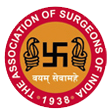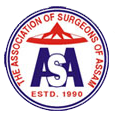“Common sense is the rarest sense” declared Violet Dawka madam in our Physiology class. And how true madam was, was proved to me upteenth number of times during the probably 20,000 (!!!) or more vivas that I had encountered in my medical career till today. When asked to enumerate the causes of jaundice in medicine viva, all that I could remember was Budd Chiary syndrome (probably the last in the long list) and nothing else!! (Not to mention that myself had suffered from “jaundice”- viral hepatitis in my childhood)
But that COMMON sense may not always bail you out of trying situations is often enlightened by scientists; so well examplified, as for example in the present instance of Congenital Diaphragmatic Hernia (CDH).
When the pathology of the CDH was demonstrated at autopsy, it was clearly obvious that the cause of the respiratory distress was the small lung volume (pulmonary hypoplasia in scientific jargaon) consequent to herniation of abdominal contents, which in turn preventing growth and expansion of the lungs. Then later-on after X-rays came into vogue, seeing the bowel shadows occupying the hemithorax, the clinician could immediately visualize the “horror filled” morbid pathology. In such trying situations, (akin to the New York scene of “i can’t breathe”, so vivid in our recent memory), sense of urgency and fear grips the frenzy and COMMON SENSE dictates removal of the strangulating hand (sic), i.e. pulling out the herniating abdominal contents out of the thoracic cavity.
Thus the “proverbial” strangulating hand now switches necks and aims for that of the surgeon (by the physician), almost threatening him to remove the confounding strangulating abdominal contents and that too instantaneously with an utmost sense of warlike emergency. Thus the moment the “Photo” (sic- CXR) lands into the hands of the physician, he/she pressurises the surgeon to take up the scalpel.
And what could the poor surgeon do in the face of such overwhelming evidence of COMMON SENSE, but to operate and pull out the “offending” viscera out of the thorax. And that exactly was what surgeons did during that (World war II ?) period and to what gratification of the dictating physicians and parents !!
But the twist in the drama starts from that point only.
For the climax or the outcome proved to be disastrous, not once but recurringly with precision. Most of these CDH babies could not make it and those few lucky ones who did, had a tumultous post operative recovery.
This unexpected turn of events did catch the eye of few surgeons and physicians (scientists) searched for an answer to it but to utter frustation. In the meantime, in the face of lack of a better option, the overwhelming tide of COMMON SENSE still got the better of the clinicians and surgeons continued the tirade. That was the period in the history of medicine when the operative outcome of CDH carried an exceptionally high mortality. This is so aptly described in our (pediatric surgery) textbook- “Historically, CDH was considered a surgical emergency.
Infants were rushed to the operating room as soon as possible after birth in the belief that reduction of the abdominal contents from the chest would relieve the compression of the lungs. Frequently, after a brief period of honeymoon period marked by adequate gas exchange, progressive deterioration in the infant’s respiratory status ensued with elevated pulmonary vascular resistance, right to left shunting, hypoxemia, ultimately death resulting from respiratory failure. Until the 1980’s the standard of care remained IMMEDIATE neonatal surgery followed by postoperative resuscitative therapy.”
“Nature and nature’s law lay hid in the dark. And the Lord said: let there be Newton, and all was light.”
Gersony in 1969 came up with the concept of Persistant Pulmonary Hypertension (PPHN). And with it the dark clouds hovering above CDH immediately got swept away. It became obvious- why these babies have hypoxemia. Why they deteriorate following operation was then but just an easy guess.
Now we know that all the ingredients for deterioration of PPHN status in a neonate, eg stress, hypoxia, acidosis, hypothermia, drugs (anesthetic drugs) are inherent in any operative procedure under General anesthesia.
So the paradigm now made a “U” turn and stratezies were directed from Urgent operation to towards control of PPHN by whatever means.
This again is reflected in the following paragraphs of the text book-
“It is essential to consider that the CDH is a PHYSIOLOGIC emergency and NOT a SURGICAL emergency.
The respiratory distress associated with CDH in the newborn results from a combination of 2 factors- UNCORRECTABLE pulmonary hypoplasia and potentially REVERSIBLE pulmonary hypertension…..Clinically both are manifested by an increase in pulmonary vascular resistance and elevated pulmonary arterial pressures, right to left shunting and progressive hypoxemia. Because there are no proven therapies to promote pulmonary vascular growth at this time, therapeutic interventions are aimed at governing pulmonary vascular tone.”
One day during my MCh training in Maulana Azad Medical College (MAMC), I saw one of our Professor of Pediatrics, carrying a large and heavy textbook on “Pain and analgesia in Neonates”. After exchange of the customary pleasantries I cautiously enquired what analgesic drug (safe and effective in neonates) the book recommends. With dreamy eyes and deep contemplative pensive moods, sir replied- NOTHING.
Gersony’s PPHN may have generated enthusiam amongst clinicians resulting in a plethora of drugs. The textbook so aptly describes-
“…tolazine…efficacy in CDH is marginal. Nitoprusside, isoproterenol, nitroglycerin, captopril….not effective. PGD², PGE¹, prostacycline, indomethacine…..disappointing. Calcium channel blockers, prostacyclin derivatives, endothelin receptor antagonists, phosphodiesterase inhibitors like sildenafil….undergoing clinical trials. Surfactant….no overall benifit….no clinical data to support. Nitric oxide…..no data to show improved survival. Role in CDH …..has not been defined”.
Yes, the ultimate result is the same as that of analgesia in neonates. Bigger the book lesser the solution it delivers. Somebody did rightly said “Simplicity lies in brevity.”
The textbook thus suggests-
A respiratory strategy based on permissive hypercapnia and spontaneous respiration has been proved to be quite successful.
Therefore what the textbook suggests is thus-
“The optimal timing of surgery when using a strategy of delayed repair also remains undetermined. The period of preopertive stabilization has varied from several days to weeks. Some authors have reported waiting untill the infant is successfully weaned off mechanical ventillation and requiring low ventillator settings. Others follow the severity of pulmonary hypertension with serial echocardiographic examinations and wait until the hypertension has abated or atleast stabilized”. The gist of the writeup is that “CDH is a PHYSIOLOGIC emergency and NOT a SURGICAL emergency” and preoperative stabilization and optimization is the key to a successful outcome following surgery.
1929 Grenwald and Steiner wrote “for the patient in whom the hernia makes its appearance at birth, little or nothing can be done from a surgical point of view.”
Yes, since then we have achieved so much. Today even in third world countries CDH babies survive, which establishes the fact that “observation” a most basic instinct of medicine combined with rational analysis can work wonders.
The above write up is an overzealous generalization and simplification of a complex topic. My idea is just to “stimulate” as the heading describes “food for thought” only.
Please excuse me for any mistake or mischief, if I have inadvertently made.


